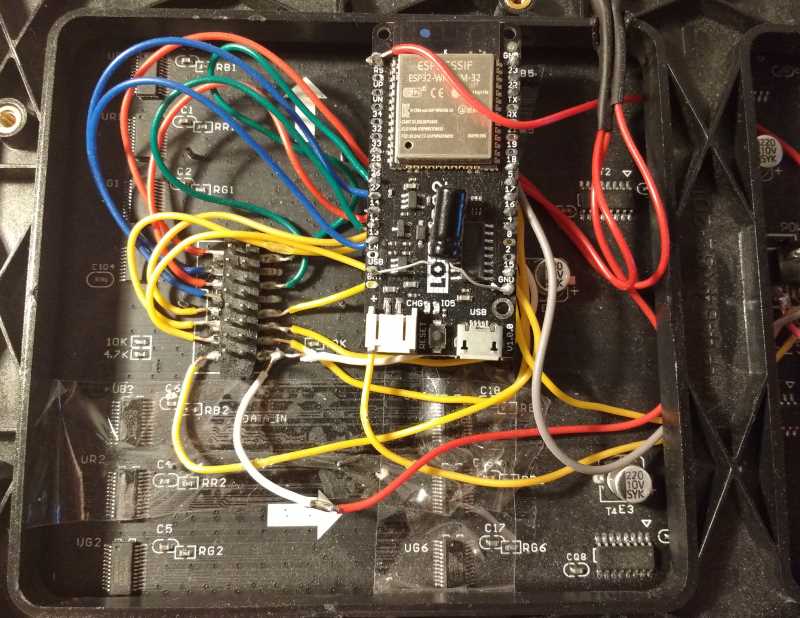| examples | ||
| ESP32-RGB64x32MatrixPanel-I2S-DMA.cpp | ||
| ESP32-RGB64x32MatrixPanel-I2S-DMA.h | ||
| ESP32-VirtualMatrixPanel-I2S-DMA.h | ||
| esp32_i2s_parallel.c | ||
| esp32_i2s_parallel.h | ||
| image.jpg | ||
| library.json | ||
| library.properties | ||
| LICENSE.txt | ||
| README.md | ||
| SPLIT_MEMORY_MODE.md | ||
| WiringExample.jpg | ||
HUB75 LED matrix library for the ESP32, utilising DMA
This ESP32 Arduino library for an RGB LED (HUB 75 type) Matrix Panel, utilises the DMA functionality provided by the ESP32's I2S 'LCD Mode' which basically means that pixel data is sent straight from memory, via the DMA controller, to the relevant LED Matrix GPIO pins with little CPU overhead.
As a result, this library can theoretically provide ~16-24 bit colour, at various brightness levels without noticeable flicker.
Installation
- Dependency: You will need to install Adafruit_GFX from the "Library > Manage Libraries" menu.
- Download and unzip this repository into your Arduino/libraries folder (or better still, use the Arduino 'add library from .zip' option.
- Library also tested to work fine with PlatformIO, install into your PlatformIO projects' lib/ folder as appropriate.
Wiring ESP32 with the LED Matrix Panel
By default the pin mapping is as follows (defaults defined in ESP32-RGB64x32MatrixPanel-I2S-DMA.h).
HUB 75 PANEL ESP 32 PIN
+-----------+
| R1 G1 | R1 -> IO25 G1 -> IO26
| B1 GND | B1 -> IO27
| R2 G2 | R2 -> IO14 G2 -> IO12
| B2 GND | B2 -> IO13
| A B | A -> IO23 B -> IO19
| C D | C -> IO 5 D -> IO17
| CLK LAT | CLK -> IO16 LAT -> IO 4
| OE GND | OE -> IO15 GND -> ESP32 GND
+-----------+
However, if you want to change this, simply provide the wanted pin mapping as part of the display.begin() call. For example, in your sketch have something like the following:
// Change these to whatever suits
#define R1_PIN 25
#define G1_PIN 26
#define B1_PIN 27
#define R2_PIN 14
#define G2_PIN 12
#define B2_PIN 13
#define A_PIN 23
#define B_PIN 22
#define C_PIN 5
#define D_PIN 17
#define E_PIN -1
#define LAT_PIN 4
#define OE_PIN 15
#define CLK_PIN 16
display.begin(R1_PIN, G1_PIN, B1_PIN, R2_PIN, G2_PIN, B2_PIN, A_PIN, B_PIN, C_PIN, D_PIN, E_PIN, LAT_PIN, OE_PIN, CLK_PIN ); // setup the LED matrix
The panel must be powered by 5V AC adapter with enough current capacity. (Current varies due to how many LED are turned on at the same time. To drive all the LEDs, you need 5V4A adapter.)
A typical RGB panel available for purchase. This is of the larger P4 (4mm spacing between pixels) type.
Can I chain panels or use with larger panels?
Yes you can. If you want to use with a 64x64 pixel panel (typically a HUB75E panel) you MUST configure a valid E_PIN to your ESP32 and connect it to the E pin of the HUB75 panel! Hence the 'E' in 'HUB75E'
This library has only been tested with a 64 pixel (wide) and 32 (high) RGB panel. Theoretically, if you want to chain two of these horizontally to make a 128x32 panel you can do so with the cable and then set the MATRIX_WIDTH to '128'. Refer to the Chained Panels example.
New Feature
With version 1.1.0 of the library onwards, there is now a 'feature' to split the framebuffer over two memory 'blocks' (mallocs) to work around the fact that typically the ESP32 upon 'boot up' has 2 x ~100kb chunks of memory available to use (ideally we'd want one massive chunk, but for whatever reasons this isn't the case). This allows non-contiguous memory allocations to be joined-up potentially allowing for 512x64 resolution or greater (no guarantees however). This is enabled by default.
Refer to this for more details.
Ghosting
If you experience ghosting, you will need to reduce the brightness level, not all RGB Matrix Panels are the same - some seem to display ghosting artefacts at lower brightness levels. In the setup() function do something like:
void setup() {
Serial.begin(115200);
matrix.setPanelBrightness(16); // SETS THE BRIGHTNESS HERE. 60 OR LOWER IDEAL.
matrix.begin(R1_PIN, G1_PIN, B1_PIN, R2_PIN, G2_PIN, B2_PIN, A_PIN, B_PIN, C_PIN, D_PIN, E_PIN, LAT_PIN, OE_PIN, CLK_PIN ); // setup the LED matrix
}
The value to pass 'setPanelBrightness' is the RGB Matrix's pixel width or less. i.e. Approx. 50 or lower. Values greater than 60 can cause ghosting it seems on some panels.
Inspiration
-
'SmartMatrix' project code: https://github.com/pixelmatix/SmartMatrix/tree/teensylc
-
Sprite_TM's demo implementation here: https://www.esp32.com/viewtopic.php?f=17&t=3188

